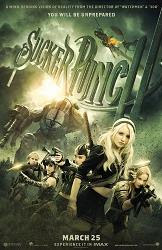
Sucker Punch is a strange movie. Yet, it would be very unlikely, if after seeing previous Zack Snyder's efforts, anyone has expected a regular film from this director. Sucker Punch is a movie about girls. Not excessively dressed, beautiful and sexy girls. It's a movie about weapons. All kinds of weapons. It's a movie about enemies. Armed, unarmed, human, bestial, weird, big, undead and what other sort of enemies you might think of. Sucker Punch is a movie about life, death, dreams, lobotomy, games, crime, dragons, sacrifice. It's a motley hodgepodge.
Sucker Punch starts with Baby Doll (Emily Browning), the main "heroine" of the movie, losing her mother. Quite soon, the girl's stepfather (Gerard Plunkett) attacks her and her sister. Baby Doll attempts a kind of counter-attack, but the end result is not good for her. She is thrown into a hospital for mentally ill patients where the manager Blue Jones (Oscar Isaac) is bribed from her stepfather to arrange a lobotomy for the young lady in order to permanently keep her silent. A doctor able to perform the lobotomy is expected to arrive in 5 days. And now, the real hodgepodge begins. Baby Doll's imagination produces a parallel world which is just a little bit nicer than the hospital but far more pleasant for the eye.
The "new" place is a brothel with skilled and young female dancers trained by Dr. Vera Gorski (Carla Gugino) to exquisitely pleasure the house's VIP guests. When Baby Doll is forced to show her dancing skills, her mind once again retreats to another world where she meets a Wise Man (Scott Glenn) who advises the girl to pursue her freedom with the help of five items she has to either obtain or discover. When Baby Doll is "back" to the brothel it appears she has turned into an incredible dancer and everyone is staring at her. She succeeds to convince four of the other girls to aid her preparing and fulfilling the escape plan. The girls are Sweet Pea (Abbie Cornish), Rocket (Jena Malone), Blondie (Vanessa Hudgens), Amber (Jamie Chung). And from then on, it's showtime. The deeper the level of dreaming, the bigger the spectacle is.
Some reviewers compare Sucker Punch with Inception and it's easy to see where their reasoning comes from. But on the other hand, if we exclude levelled dreaming and a few hints of possible but not certain shared dreaming, there are not too many similarities with the Christopher Nolan's film and it's hard to say Sucker Punch is just an Inception clone movie. In addition, the ending of Inception has been widely open to interpretations, whereas Sucker Punch ends rather unambiguously. In a way, its ending has more resemblance to another 2010 film starring Leonardo DiCaprio, Shutter Island, than to the Nolan's movie. And in terms of quality, it is questionable whether the both films are comparable because although Inception has been a far from perfect movie, there is even more to be desired from Sucker Punch.
And if you ask, what more do you want from a film with so many hot chicks in it... Sucker Punch is a mess. There is even a point in the movie (after, let's say, the first "second level" dreaming) where you may wonder what is really happening since the film has been looking like 3 completely unrelated stories up to this moment. The number of "stories" continues to grow as the movie progresses but at least some system appears in the initial chaos. The script is not a strong side of the film either and there are several cases of characters' behavior that do not seem well motivated or clearly explained. Sucker Punch carries out an expendable "you are your own God" message that is kind of artificially embedded into the movie. Finally, many of the visuals and techniques used in the film have been already exploited a lot, e.g., bullet special effects, slow motion, etc.
Then why would you possibly go see this movie? Well, there are moments beautiful to watch, either the gorgeous girls, or the exuberant visuals. The film is colorful in pretty much every aspect. If you are a gamer, the second level dreaming sequences offer a variety of game references. The music is primarily loud and although not being very original, there are noticeable covers of popular artists like the Beatles or Eurythmics. The score is what one would expect from a Zack Snyder's movie thus if you are into that sort of music, it's another plus for you.
And practically, this is it. If you want to see a film made primarily for your senses, Sucker Punch is a good choice. If you want a deeper story with less fireworks and noise, just skip this movie.
Go through our Maze of Reviews to find out more movie reviews.






